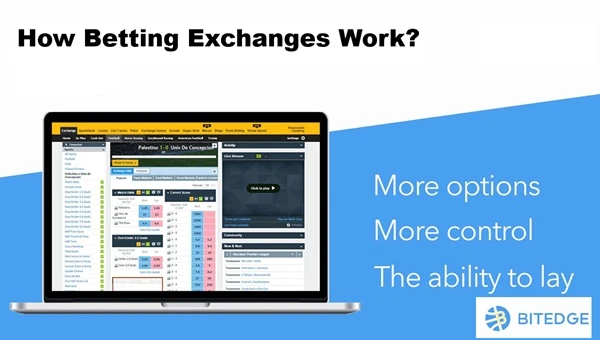What is a betting exchange?
On betting exchanges, you don’t bet against the operator you bet against other customers with the exchange acting as an intermediary.
This means you can “Back” and “Lay”. The backing is betting that an outcome will happen; when you back you bet against the layers. Laying is betting that an outcome will not happen; when you lay you bet against the backers.
So if you want to bet that Spain will win the World Cup you can back them to win, just like you would normally bet at the sportsbook. If you want to bet that Spain will not win, you can lay them. In this case, you have every other team in the competition playing for you. Your lay bet wins if any team other than Spain wins.
Laying is taking the place of a sportsbook. If you win the bet you keep the backer’s stake. If you lose the bet you have to pay out the backer’s stake multiplied by the odds, just like a sportsbook does.
In this process the exchange
- Puts up the market with selections for betting on.
- Matches backers and layers and displays unmatched bets.
- Holds the backers and layers money aside while the outcome is pending.
- Pays out the winner with the losers’ money.
- Takes a 2% – 4% commission from the winner’s profit.
Unlike sportsbooks, exchanges don’t want you to lose. They have no position in the outcome of any bet.
The exchange model has 2 big advantages.
1. Better odds
Betting exchanges commission is less than sportsbooks overround. A 2% commission is equivalent to a 1% overround.
2. The ability to lay
This gives you more options and control as detailed below.
Stake and odds when laying
When you lay a selection, you will win the backer’s stake if that selection loses, no matter what the odds are. However, if the selection wins, you will have to pay out the backer’s profit based on the odds. Take the following scenario
Selection: Spain
Odds: 3
Backers stake: 1 m฿
If Spain loses, the layer wins 1 m฿. If Spain wins the layer has to pay the backer 2 m฿. The backer will receive 3 m฿ but 1 m฿ of that was his original stake, it does not come from the layer.
Now imagine the same bet but with odds of 1.2. If Spain loses, the layer wins 1 m฿. If Spain wins the layer has to pay the backer 0.2 m฿. This shows why the layer wants low odds.
The layer’s liability is held aside just like a backer’s stake is held aside, until the bet results. A layer cannot get a bet on unless he has the funds in his account to cover the liability.
The bet slip on the exchange will tell you what your liability would be on a lay bet.
- The calculation is:
(backer’s stake * odds) – backers stake = layer’s liability
- This can also be expressed as:
backer’s stake * (odds – 1) = layer’s liability
- From the example above, if the backer’s stake is 1 m฿, the odds are 1.2 and the selection wins, then the layers’ liability is:
(1 m฿ * 1.2) –1 m฿ = 0.2 m฿

Set Your Own Odds
To get your bets matched you can either take the best odds available at the time or request better odds by putting up an unmatched bet and hoping another user will take it.
Your unmatched bet will go into the queue. If you are a backer, your bet becomes available for the layers to match if they like the odds. If you are a layer, your bet becomes available for the backers to match if they like the odds.
The backers want the highest odds possible but the layers want the lowest odds possible. That’s why exchanges display the unmatched back bets with the highest odds at the front of the back queue and the unmatched lay bets with the lowest odds at the front of the lay queue.
If you are a backer and you request odds that are higher than the best available back price, but still lower than the best available lay price, your unmatched back bet will be at the front of the lay queue. For example
- Current best back price: 2.14
- Current best lay price: 2.2
If you put up a request to back at 2.18 your bet becomes available for layers to lay at the front of the queue, because it’s now the lowest (best) available lay price. Being at the front of the queue means you have a good chance of being matched.
However, if you put up a request to back at the odds of 2.22, a layer has no reason to accept your offer because lower (better) odds of 2.2 are already available. In that case, your unmatched bet will be behind 2.2 in the queue.
If the following conditions are true you can be confident that taking the best price available will get you good value and there is no need to try to set your own odds.
- The event start time is closed.
- A lot has already been matched on the market.
- There is a small difference between back and lay odds.
Liquidity
Liquidity refers to how much money is being matched on a market. Betting exchange markets need a lot of liquidity to produce competitive odds and large bet sizes. For that reason, they display how much has already been matched on a market and individual selections.
When you bet a lot on a particular sport or league at an exchange, you will get a feel for how much liquidity a market needs for the odds to be competitive. If there is not enough liquidity for good odds you will need to set your own by putting up an unmatched bet.
Trading and hedging
Trading is backing a selection at a higher price and laying it at a lower price. If you can do this you can win no matter what happens. It is like buying shares at a low price and then selling them at a high price.
For this to work you would need the odds on a selection to come down after you have backed it, or for the odds on a selection to go up after you have laid it. If you back a selection and then the odds go up, you will not be able to trade into a guaranteed profit but you can still hedge out of your risk.
For how to do this see arbitrage betting, trading, and hedging.
Conclusion
The only way to really appreciate the features mentioned in this article is to get on an exchange and give it a go. Greater understanding will come with real use of the exchange model. Get your hands dirty with betting exchanges and it will change the way you bet and your profitability forever.
A pro writer since 2015, immersed in the world of crypto since 2016, Will built up a wealth of knowledge and experience in both crypto gambling and crypto betting, making him one of the most prominent voices in the industry. His high-quality reviews have been featured on prominent gaming platforms, making him a trusted authority in the field.
Nationality
British
Lives In
England



 Fact checked by
Fact checked by 

 will.wood.9964@gmail.com
will.wood.9964@gmail.com 